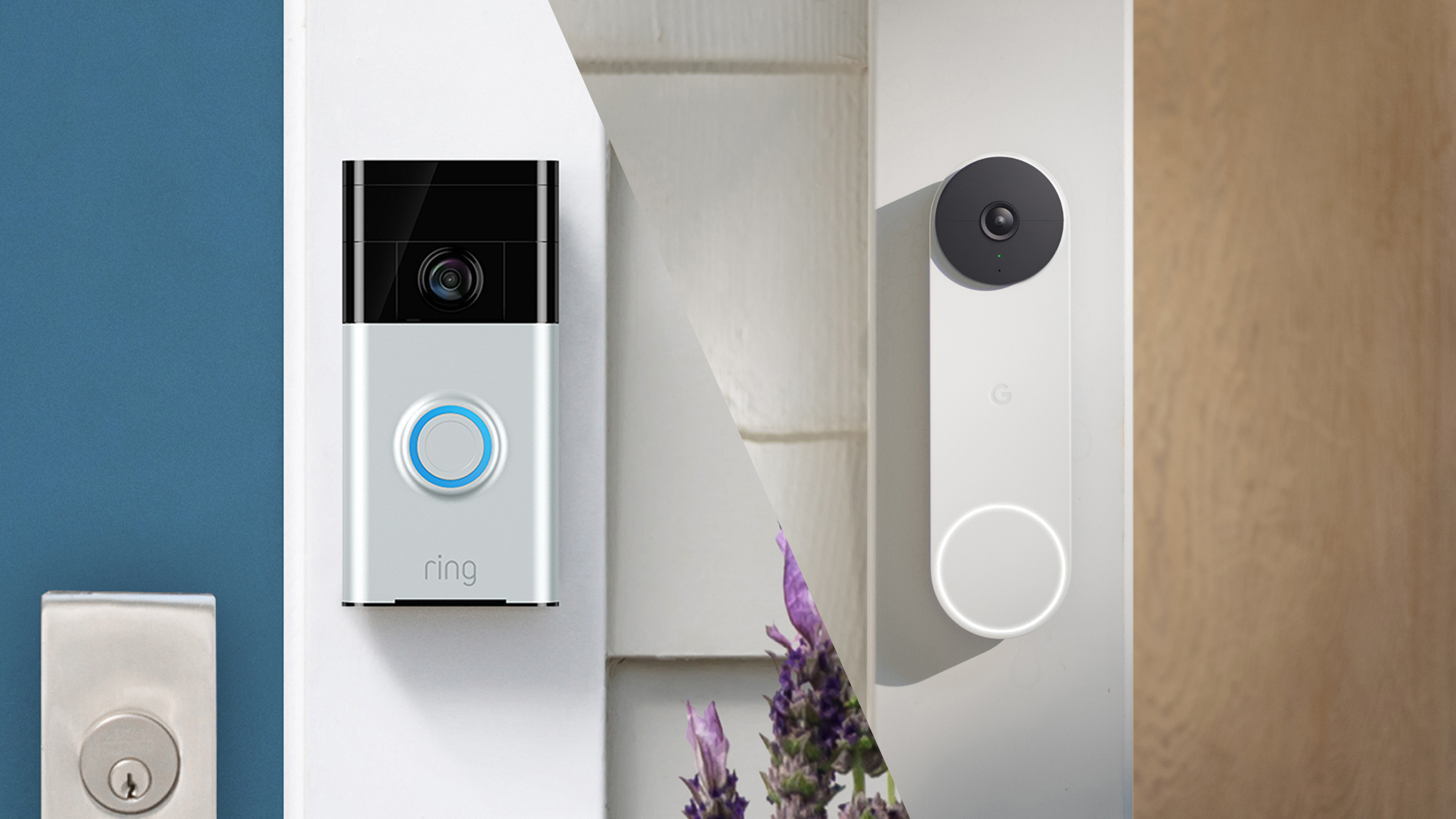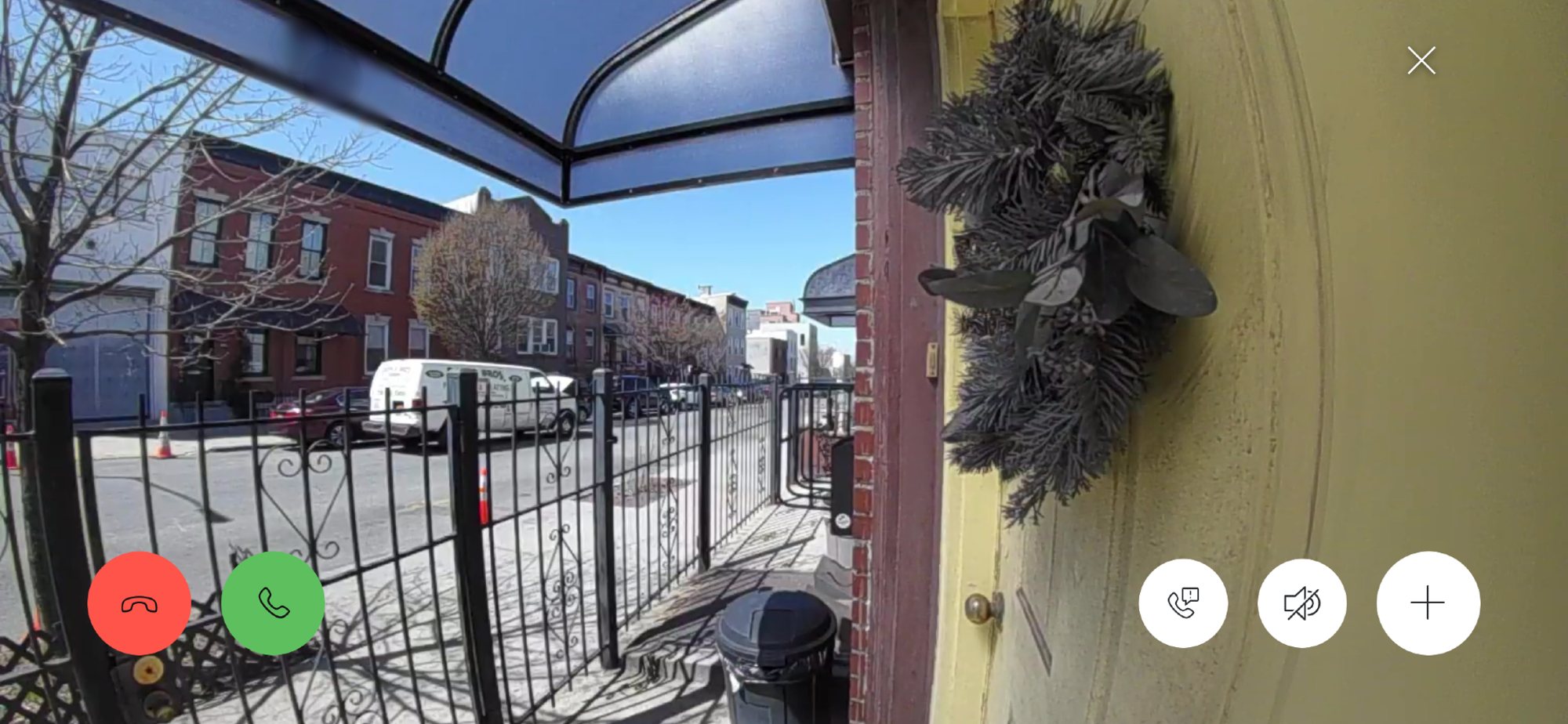
The Google Nest Doorbell (battery) delivers a wide, crisp image, and includes person, package, and vehicle detection for free, along with three hours of local storage. However, you have to remove the whole thing if you want to recharge its battery, and Google doesn't make a chime that pairs with the device.
For
- Very sharp video quality
- Free person, animal, package, vehicle detection
- 3 hours of video storage free
- Works both wired and battery power
Against
- Only works with Google Home
- No optional chime
- Limited accessories
Ring's video doorbell has head-to-toe video, can run on battery power or be hardwired, and has package detection (if you get a subscription). It also works with a ton of accessories, including a digital chime that acts as an extender.
For
- Works both wired and on battery power
- Easy to install
- Good quality video
- Inexpensive
Against
- More difficult to recharge than other models
- Doesn’t show base of door
As you look for a new video doorbell, you may be trying to decide between buying a Ring vs. Nest. And with good reason: Ring and Nest both make some of the best video doorbells. But with nine video doorbells between the two companies, it's tough to decide which is the best.
Ring has eight video doorbells, from the $59 Ring Video Doorbell Wired to the Ring Video Doorbell Elite ($349), while Nest offers just two: the Nest Doorbell (wired) and the Nest Doorbell (battery), both for $179. But selection isn't everything. Both companies' models are among the best video doorbells around, so choosing between the two can be tricky. We'll break down the features and costs of both Ring and Nest video doorbells, to help make your decision easier.
Ring vs. Nest: Pricing and options
Nest has two video doorbells — the Nest Doorbell (battery) and the Nest Doorbell (wired). Both cost $179.
Ring offers eight different models: the Ring Video Doorbell Wired ($49), the Ring Battery Doorbell ($99), the Ring Battery Doorbell Plus ($149), the Ring Battery Doorbell Pro ($229), the Ring Wired Doorbell Plus ($149), the Ring Wired Doorbell Pro ($249), the Ring Peephole Cam ($129) and the Ring Video Doorbell Elite ($349).
For the purposes of this faceoff, we're just going to compare the Nest Doorbell (battery) to the Ring Battery Doorbell Plus, since they're the most alike in price and features.
The Nest Doorbell comes in four colors (Snow, Linen, Ash, and Ivy), while the Ring only comes in Satin Nickel. However, Ring does sell extra faceplates for its video doorbell starting at $14.99, some of which are holiday-themed.
Bear in mind that there are bound to be a lot of Black Friday deals on both Ring and Nest doorbells, so be sure to look out for sales on these devices as we approach Black Friday itself.
Winner: Tie
Ring vs. Nest: Specs compared
Ring vs. Nest: Design
A video doorbell is going to be one of the first things a visitor sees when they get to your front door, so it should look nice, right? But, there are also some practical considerations to take into account, too.
Let's start with size: At 5.1 x 2.5 x 1.1 inches, the Ring Video Doorbell is shorter, but wider, than the 6.3 x 1.8 x 0.95-inch Nest Doorbell Battery. So, if you have a particularly narrow door frame, the Nest may fit better.
Ring's video doorbell has a two-tone look — the top third is black, while the bottom is silver. It's nearly the same design that's been going back for years, and while it's not as modern-looking as the Nest, it's just fine. Ring's video doorbell only comes in one color, but you can swap out the bottom silver faceplate for other colors, and Ring even makes seasonal faceplates for Halloween, Christmas, and other holidays.
While it's larger, the Ring Battery Doorbell does hold one other advantage over the Nest: The Ring's battery can be removed. So, if you're running it on battery power alone, you can simply swap out the battery for a second one, rather than having to take the entire video doorbell off your door to recharge it.
Both companies also sell solar panels to help you keep the doorbells' battery charged longer; Ring's has a more seamless design, which wraps around the doorbell itself.
Winner: Ring
Ring vs. Nest: Installation
Both the Nest Doorbell (battery) and the Ring Battery Doorbell Plus can use either a wired connection or run off internal batteries. This not only makes installation easier but also gives you more options for where you can place it. However, Ring's battery is removable, so you don't have to take the entire unit off your door to recharge it. The Nest's battery is non-removable, so you'll be facing some time when you don't have a doorbell.
Ring also offers the Ring Chime ($29) and Ring Chime Pro ($49) as an alternative to a traditional doorbell chime. Ring's Chimes simply plug into an outlet, and can be programmed to make different sounds based on both detected movement and someone ringing the bell. The Chime Pro also acts as a Wi-Fi repeater, handy if your front door is out of range of your home Wi-Fi network.
Nest does not offer a separate chime; instead, you'd need to use something like the Nest Mini ($25) if you want to hear the bell ring.
Both the Nest and the Ring took roughly the same amount of time to install. If you want to see how it's done, be sure to check out our guide on how to install a Ring video doorbell.
Winner: Ring
Ring vs. Nest: Video quality

One of the chief concerns when buying a video doorbell is the video quality. The Nest Doorbell (wired) has a resolution of 960 x 1280. That's lower than the Ring Battery Doorbell Plus (1536p), but resolution doesn't tell the whole story.
The Nest Doorbell has a 3:4 aspect ratio, while the Ring has a squarish aspect ratio. In both cases, that means that you can see more of what's going on at the foot of your door, where packages are most likely to be dropped off.

The Nest also supports HDR, which we found helped when a visitor was shaded (when standing on a covered porch, for instance) and the background was brightly lit.
Winner: Tie
Ring vs. Nest: Features
The Ring Battery Doorbell Plus and the Nest Doorbell (battery) have many comparable features, but in a few cases, Nest's are a bit more robust.
Custom motion zones
Both video doorbells let you designate areas within the camera's field of view that it should ignore if motion is detected. Both are easy to set up and configure, and let you create polygonal shapes.
Person detection
Both video doorbells have person detection, which can greatly cut down on the number of notifications you receive. With this feature enabled, you only get alerted when the camera detects a person. However, the Nest Doorbell takes this a step further with facial recognition and can send you a special alert when a friend or family member is at the door. This is only available with a subscription, though.
Package detection
Both the Nest Doorbell and the Ring have this feature, and can tell you not only when a package has been delivered, but when one has been picked up, too. If you're going to get one feature on a video doorbell, it's this.
Continuous video recording
Neither camera has continuous video recording; for that, you'd need the Nest Doorbell (wired), which offers 10 days of recording if you subscribe to a Nest Aware plan.
Neighborhood Alerts
Ring also has a Neighborhood Alert feature, where you can view incidents from other Ring users in your area, as well as post video from your own camera(s).
End-to-end video encryption
Ring launched end-to-end video encryption for its video doorbells and home security cameras; unfortunately, this feature is not available for its battery-powered devices, such as the Ring Video Doorbell. This is an important feature, as end-to-end encryption is the only sure way to prevent local law enforcement from accessing your Ring video footage. Here's how to enable end-to-end encryption on a Ring video doorbell; however, by doing so, you'll also disable a number of features.
Extended video recording
Often with video doorbells, a person moves so quickly through the frame that by the time the camera senses motion and starts recording, you can only see the back of the person. Ring solves this problem by continuously recording a 4-second loop; when the camera does detect motion, it then tacks on those few seconds prior to the event, so that you hopefully can see all of the person. Because it has to be able to work using battery power alone, Ring's Pre-roll records this video in a lower resolution.
The Nest Doorbell (battery) does not have a comparable feature; however, the hardwired Nest Hello does have a full-color, full-resolution pre-roll feature, as does the Ring Video Doorbell Pro 2.
Local storage
What happens if your Wi-Fi goes down, or the power goes out? The Nest doorbell can save up to three hours of video history internally, so that there's less of a chance that you'll miss something if there's an interruption in service. None of Ring's video doorbells have this feature.
Winner: Nest
Ring vs. Nest: Smart home compatibility
One of the advantages of a smart doorbell is that you can link it other gadgets on our list of the best smart home devices. So, for example, you could have your front-porch lights turn on when someone approaches your door at night.
As two of the best Google Assistant commands and best Alexa skills, both the Nest and Ring cameras will work to some extent with both Alexa and Google Assistant. Using voice commands, you can ask about the status of the cameras. If you have the Nest Doorbell, Google Home devices can also announce visitors.
Nest's video doorbell also works with Alexa; when you pair the device with Amazon's assistant, your Alexa-enabled smart speaker will be able to announce if a person or package is at the door.
If you have an Alexa-enabled smart display (like the Echo Show) or a Fire TV device, you can view a live feed from both the Nest and Ring doorbells. It's handy if you're in your bedroom and can't get to the door as quickly as you'd like. Additionally, you can link Ring's Video Doorbells to a plethora of other Ring products, such as its outdoor lights and motion sensors, so that the doorbell will start recording as soon as some other device detects movement.
Ring also has a partnership with Lutron; when a Ring camera detects motion or the button on a video doorbell is pressed, you can program Lutron-controlled lights to turn on. You can also customize the interaction to only occur at night.
Alexa lets you create more interactions between Ring cameras and other smart home devices than you could with Nest cameras and Google Assistant. Recent updates to Google Home now mean that you can do more with its devices, but you still can't create a routine where a smart home device is triggered when your Nest video doorbell sees someone.
You can, however, use the Chromecast with Google TV or Google TV Streamer device, as well as the Google Pixel Tablet or Nest Hub to view a live feed from your Nest video doorbell.
Unfortunately, neither Ring nor Nest work natively with HomeKit; however, the Starling Home Hub, one of the best smart home hubs, lets you connect Nest products with HomeKit.
Winner: Ring
Ring vs. Nest: Subscription fees
To get the most out of the Nest and Ring doorbells, you'll need to subscribe to a monthly plan. For example, in order to get continuous recording and intelligent alerts that tell you who's at your door, you'll need to subscribe to Nest Aware, the company's cloud-recording solution.
Nest Aware starts at $8 per month (or $80 annually), you can store 30 days of event history from an unlimited number of cameras at one location; if you upgrade to Nest Aware Plus ($15/month, $150 annually), you get 60 days of rolling cloud storage, plus 10 days of 24/7 video history, which means that you can look at any moment in time over the previous 10 days.
By comparison, Ring's basic plan costs $4 a month ($40 per year) per device and gets you 180 days of recordings. Ring Plus, which costs $10 per month (or $100/year), supports unlimited cameras and also gives you 180 days of event storage, but not 24/7 video history.
However, with the Nest Doorbell, you get for free three hours of rolling video storage, as well as person, animal, vehicle, and package detection, as well as custom motion zones. You have to pony up for a Ring subscription before you get those features.
For a more detailed look at the plans for Nest, Ring, and Arlo, check out our comparison of security camera storage plans.
Winner: Nest
Ring vs. Nest: Overall Winner
When it comes to Ring vs. Nest, in the end, the Ring Battery Doorbell Plus edges out the Nest Doorbell (battery) by a hair. Ring's video doorbell is more versatile in that you can use it either wired or on battery power alone, and that you can simply remove the battery, rather than the entire doorbell, when you need to recharge it.
Additionally, Ring's video doorbell works better in concert with other smart home devices; not only is Ring's own ecosystem more robust, but you can do a lot more with it when you connect it to other smart home devices using Alexa.
However, the Nest Video Doorbell is no slouch. We liked the fact that you get facial recognition and package detection for free, whereas you need to sign up for a subscription to get these features with Ring. And, although you can't save as long a video history as with Ring, Nest's basic subscription plan is more cost-effective if you have three or more cameras.
Ultimately, both cameras are pretty great, so picking the best one for you will come down to what you're looking for in a video doorbell.







